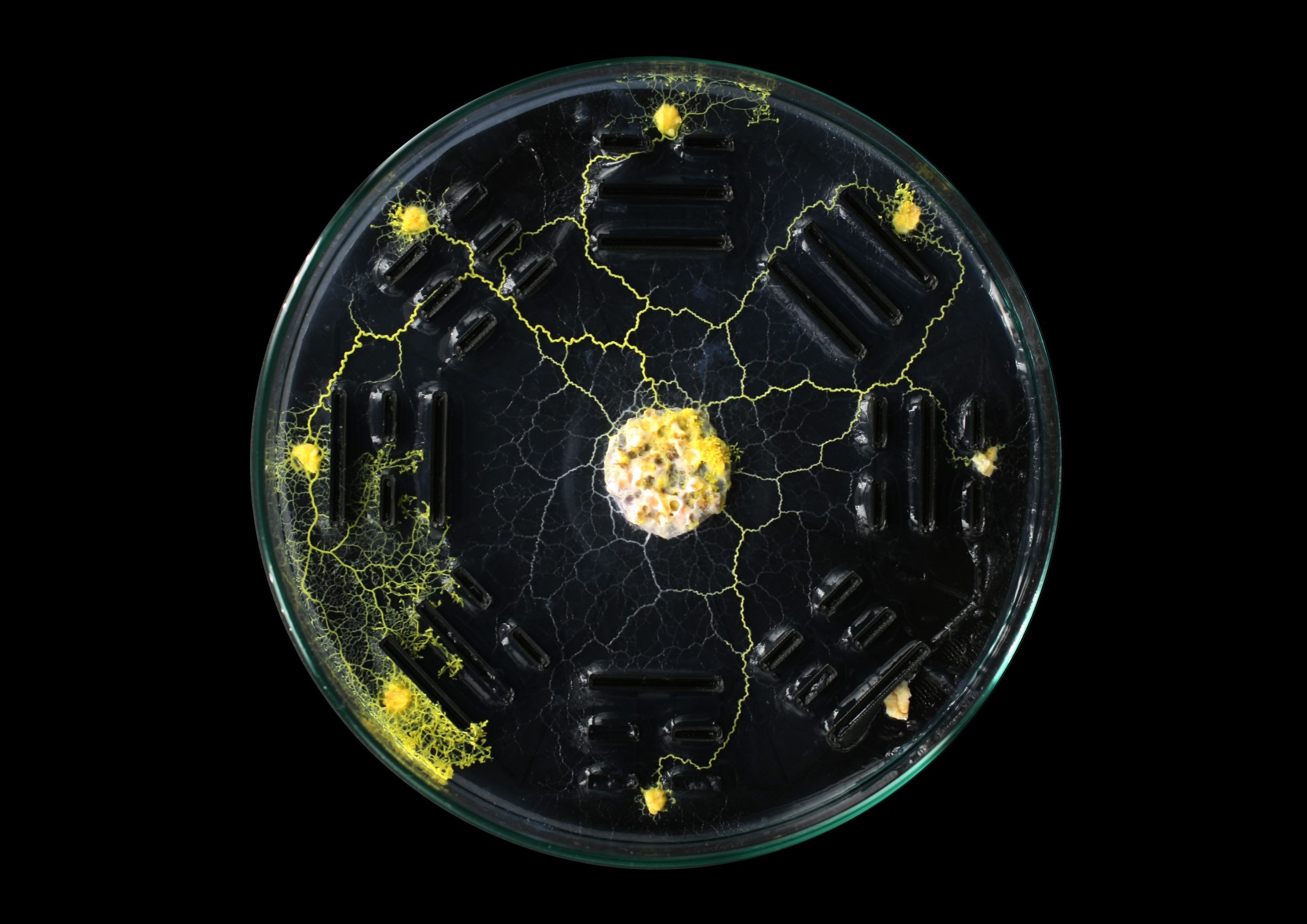Interspecies Incubation I
Up to now, the generation of ideas has been described as an exclusive faculty of humans. One of the first research approaches of the idea generation process was presented by the British social psychologist Graham Wallas (1926) (cf. Qualter, 1980), which served as a basis for many subsequent theories (cf. Guilford, 1950; Kneller 1965; Ulmann, 1973; Lawson, 1991; Kounios/Beeman, 2015). He divides this process into a four-stage model, which includes the phases of preparation, incubation, illumination and verification. (cf. Vollmer, 2020) Especially the unconscious or intuitive states during the incubation phase, which are named in many theoretical studies as essential for idea genesis (cf. Smith/ Dodds, 1999; Dodds et al., 2003; Sio and Ormerod, 2009; Gilhooly et al, 2013; Kounios/Beeman, 2015; Vollmer, 2020), still raise many questions especially in the scientific context in connection with external matter. The approach to explore the incubation phenomenon is often done only with rational models of thought such as statistics and analysis. But it doesn’t incorporate the unpredictability and complexity of matter charged with coincidence and metastability (between a chaotic and a stable state). Furthermore, recent results from neuroscience indicate that incubation processes possess not only passive components (for example, the relaxation of various brain areas), but are also involved in higher functions such as different states of consciousness and concentration (cf. Pizoli et al, 2011; Roach et al, 2018). In addition, the incubatory state can be understood as an “intra-action” (cf. Barad, 2005) with external “rhythms of matter” and the world (cf. Diamond et al, 2008; Boussard et al, 2021; Minissale, 2021). Accordingly, I hypothesize that incubation can be seen as an essential and active part of an unconscious contact with materiality, which is also important for the processing of information and represents its own form of constellation of consciousness, while the unconscious becoming is constituted. Due to the fact that the problems of the future are subject to a constant increase of complexity, and the anthropocentric thinking can no longer be regarded as up-todate, it needs a holistic connection to non-human rhythms of matter to be able to promote the absorption of complex information diversity. But in order to create an awareness of the active processes of incubation, an interdisciplinary perspective of the entanglement between the substance of mind and the substance of matter and the world is needed, which in turn results in various points of confrontation or friction. Especially the theories of New Materialism and in particular Karen Barad’s approach of “agential performativity” allow new perspectives on the relations between matter and performativity (cf. Barad, 2007). Therefore, this interdisciplinary research project attempts to make those incubatory entanglements tangible with the help of machine actors (neuronal networks) as well as biological participants (Physarum polycephalum/ slime mold) in the form of an artistic speculative examination (cf. Dunne/Raby, 2013). On the one hand there will be created a composition of incubation assemblages and on the other hand a workshop. These incubation assemblages will be developed together with scientists, who will exchange approaches and methods from the fields of microbiology, computer science, psychology and communication design. In this way, new possibilities for the mediation of senso-aesthetic rhythmic experiences with non-human actors are to be designed, in which the technical as well as biological participants are not anthropomorphized, but freed from their passive role of the exploited other. Thus, the research project „Interspecies Incubation“ tries to generate a sensitization for those complex active entanglements and a new perspective in the recipients with a speculative openness as well as transdisciplinarity and the associated engagement with uncertainty, which is detached from human-centered paradigms. This should interweave human consciousness or subconsciousness and action in a new way and tries to break through conventional models of thinking.
REFERENCES
Barad, K. (2007): Meeting the Universe Halfway: Quantum Physics and the Entanglement of Matter and Meaning, Duke University Press, Durham, London
Dodds, R.D. / Ward, T.B. / Smith, S.M. (2003): “Incubation in problem solving and creativity”. In: Runco, M.A. (Hrsg.): The Creativity Research Handbook (Vol.3), Hampton Press, Cresskill, NJ.
Dunne, A. / Raby, F. (2013): Speculative everything – design, fiction, and social dreaming. The MIT Press, Cambridge, Massachusetts, London.
Ehrenzweig, A. (1967): The Hidden Order of Art. A Study in the Psychology of Artistic Imagination. Granada Publishing Ltd., London
Gilhooly, K.J. / Georgiou, G.a / Devery, U. (2013): Incubation and creativity: do something different. Think. Reason. 19, Routledge, London, S. 137-149.
Guilford, J. P. (1950). Creativity. American Psychologist, 5, S.444-454.
Kneller, G. F. (1965): The Art and Science of Creativity. Holt, Rinehart and Winston, New York.
Kounios, J. / Beeman, M. (2015): The Eureka factor: Aha moments, creative insight, and the brain. Random House Verlag, New York.
Lawson, B. (1991): How Designers Think: The Design Process Demystifi. 2d ed. The University Press, Cambridge.
Minissale, G. (2021): Rhythm in Art, Psychology and New Materialism. Cambridge University Press. Kindle-Version.
Qualter, T. H. (1980): Graham Wallas and the Great Society. The Macmillan Press LTD, London, Basingstoke.
Sio, U.N. / Ormerod, T.C. (2009): Does incubation enhance problem solving? A meta-analytic review. Psychol.Bull. 135, American Psychological Association, S. 94-120.
Smith, S.M. / Dodds, R.A. (1999): Incubation. In: Business Incubation. International Case Studies. EncyclopediaCreat. 2, OECD, Paris, S. 39-43.
Ulmann, G. (1973): Kreativitätsforschung. Kiepenheuer und Witsch, Köln.
Vollmer, B. (2020): Kreativität – Handeln in Ungewissheit. Eine Studie zur Relevanz individueller und ko-konstruktiver kreativer Prozesse. Springer VS, Wiesbaden.
Wallas, G. (1926): The Art of Thought. Butler and Tanner LTD, Frome, London.
date
since 2021
role
conception / artistic research / text / layout
context
PhD thesis









